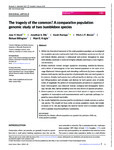The tragedy of the common? A comparative population genomic study of two bumblebee species
| dc.contributor.author | Huml, JV | |
| dc.contributor.author | Ellis, Jonathan | |
| dc.contributor.author | Rustage, S | |
| dc.contributor.author | Brown, MJF | |
| dc.contributor.author | Billington, Richard | |
| dc.contributor.author | Knight, Mairi | |
| dc.date.accessioned | 2023-02-01T11:28:23Z | |
| dc.date.available | 2023-02-01T11:28:23Z | |
| dc.date.issued | 2023-01-28 | |
| dc.identifier.issn | 1752-458X | |
| dc.identifier.issn | 1752-4598 | |
| dc.identifier.uri | http://hdl.handle.net/10026.1/20223 | |
| dc.description.abstract |
Within the theoretical framework of the small population paradigm, we investigated the population genomics and parasite load of two bumblebee species across the UK and Ireland. Bombus pratorum is widespread and common throughout its range while Bombus monticola is restricted to higher altitudes and shows a more fragmented distribution. Bombus monticola showed stronger population structuring, isolation-by-distance, and a deficit of heterozygotes in the most isolated population in the south of its range (Dartmoor). Heterozygosity and inbreeding coefficients (FIS) were comparable between both species, but the proportion of polymorphic sites was much greater in B. pratorum. Notably, both species have suffered significant declines in Ne over the last 100 generations and estimates and declines for both species were of similar orders of magnitude. No pattern of increased parasite prevalence in populations of lower heterozygosity was observed. Instead, ecological and demographic factors (age, latitude, date, habitat suitability) were the main drivers of parasite prevalence. Distinct patterns of selection were observed in both species in regions involved in regulation of transcription and neurotransmission and in particular pathways targeted by neonicotinoid insecticides. Our results highlight the pressing need for monitoring to include common as well as rare species. This should not focus solely on census population counts, but include estimates of Ne. We also highlight the need for further work to establish adaptive shifts in globally important pollinator communities. | |
| dc.format.extent | 335-354 | |
| dc.language | en | |
| dc.language.iso | en | |
| dc.publisher | Wiley | |
| dc.subject | biodiversity loss | |
| dc.subject | Bombus | |
| dc.subject | effective population size | |
| dc.subject | parasite load | |
| dc.subject | pollinators | |
| dc.subject | RAD-seq | |
| dc.subject | small population paradigm | |
| dc.title | The tragedy of the common? A comparative population genomic study of two bumblebee species | |
| dc.type | journal-article | |
| dc.type | Journal Article | |
| plymouth.author-url | https://www.webofscience.com/api/gateway?GWVersion=2&SrcApp=PARTNER_APP&SrcAuth=LinksAMR&KeyUT=WOS:000922752000001&DestLinkType=FullRecord&DestApp=ALL_WOS&UsrCustomerID=11bb513d99f797142bcfeffcc58ea008 | |
| plymouth.issue | 3 | |
| plymouth.volume | 16 | |
| plymouth.publication-status | Published | |
| plymouth.journal | Insect Conservation and Diversity | |
| dc.identifier.doi | 10.1111/icad.12626 | |
| plymouth.organisational-group | /Plymouth | |
| plymouth.organisational-group | /Plymouth/Faculty of Science and Engineering | |
| plymouth.organisational-group | /Plymouth/Faculty of Science and Engineering/School of Biological and Marine Sciences | |
| plymouth.organisational-group | /Plymouth/REF 2021 Researchers by UoA | |
| plymouth.organisational-group | /Plymouth/REF 2021 Researchers by UoA/UoA06 Agriculture, Veterinary and Food Science | |
| plymouth.organisational-group | /Plymouth/Users by role | |
| plymouth.organisational-group | /Plymouth/Users by role/Academics | |
| dcterms.dateAccepted | 2023-01-04 | |
| dc.rights.embargodate | 2023-2-2 | |
| dc.identifier.eissn | 1752-4598 | |
| dc.rights.embargoperiod | Not known | |
| rioxxterms.versionofrecord | 10.1111/icad.12626 | |
| rioxxterms.licenseref.uri | http://www.rioxx.net/licenses/all-rights-reserved | |
| rioxxterms.type | Journal Article/Review |


